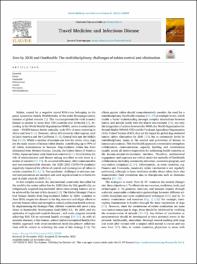| dc.contributor.author | Bonilla-Aldana, D. Katterine | |
| dc.contributor.author | Ruiz-Saenz, Julian | |
| dc.contributor.author | Martinez-Gutierrez, Marlen | |
| dc.contributor.author | Villamil-Gomez, Wilmer | |
| dc.contributor.author | Mantilla-Meluk, Hugo | |
| dc.contributor.author | Arrieta, German | |
| dc.contributor.author | León-Figueroa, Darwin A. | |
| dc.contributor.author | Benites-Zapata, Vicente | |
| dc.contributor.author | Barboza, Joshuan J. | |
| dc.contributor.author | Muñoz-Del-Carpio-Toia, Agueda | |
| dc.contributor.author | Franco, Oscar H. | |
| dc.contributor.author | Cabrera, Maritza | |
| dc.contributor.author | Sah, Ranjit | |
| dc.contributor.author | Al-Tawfiq, Jaffar A. | |
| dc.contributor.author | Memish, Ziad A. | |
| dc.contributor.author | Amer, Fatma A. | |
| dc.contributor.author | Suárez, José Antonio | |
| dc.contributor.author | Henao-Martinez, Andres F. | |
| dc.contributor.author | Franco-Paredes, Carlos | |
| dc.contributor.author | Zumla, Alimuddin | |
| dc.contributor.author | Rodriguez-Morales, Alfonso J. | |
| dc.date.accessioned | 2023-05-29T17:20:13Z | |
| dc.date.available | 2023-05-29T17:20:13Z | |
| dc.date.issued | 2022-11-21 | |
| dc.identifier.uri | https://hdl.handle.net/20.500.13053/8631 | |
| dc.description.abstract | “Rabies, caused by a negative strand RNA-virus belonging to the
genus Lyssavirus (family Rhabdoviridae of the order Mononegavirales),
remains of global concern [1]. This vaccine-preventable viral zoonotic
disease is present in more than 150 countries and territories [2]. Ac-
cording to the World Health Organization (WHO), rabies is estimated to
cause ~59,000 human deaths annually, with 95% of cases occurring in
Africa and Asia [3,4]. However, rabies still occurs in other regions, such
as Latin America and the Caribbean [5–8], Central Asia and the Middle
East [9,10]. Whilst a number of animals can host the rabies virus, dogs
are the main source of human rabies deaths, contributing up to 99% of
all rabies transmissions to humans. Dog-mediated rabies has been
eliminated from Western Europe, Canada, the United States of America
(USA), Japan and some Latin American countries [11]. Nevertheless, the
risk of reintroduction and disease among travellers to risk areas is a
matter of concern [12–15]. As occurred with many other communicable
and non-communicable diseases, the 2020–2022 COVID-19 pandemic
negatively impacted the efforts of control and reemergence of rabies in
certain countries [7,16,17]. Post-pandemic challenges to enhance con-
trol and prevention are multiple and need urgent actions to achieve the
goal in eight years by 2030 [16].“ | es_PE |
| dc.format | application/pdf | es_PE |
| dc.language.iso | eng | es_PE |
| dc.publisher | Elsevier Inc. | es_PE |
| dc.rights | info:eu-repo/semantics/openAccess | es_PE |
| dc.rights.uri | https://creativecommons.org/licenses/by/4.0/ | es_PE |
| dc.subject | Rabies, OneHealth, Multisectoral, Control, Prevention, Multidisciplinary | es_PE |
| dc.title | Zero by 2030 and OneHealth: The multidisciplinary challenges of rabies control and elimination | es_PE |
| dc.type | info:eu-repo/semantics/article | es_PE |
| dc.identifier.doi | https://doi.org/10.1016/j.tmaid.2022.102509 | |
| dc.type.version | info:eu-repo/semantics/publishedVersion | es_PE |
| dc.publisher.country | US | es_PE |
| dc.subject.ocde | 3.00.00 -- Ciencias médicas, Ciencias de la salud | es_PE |


